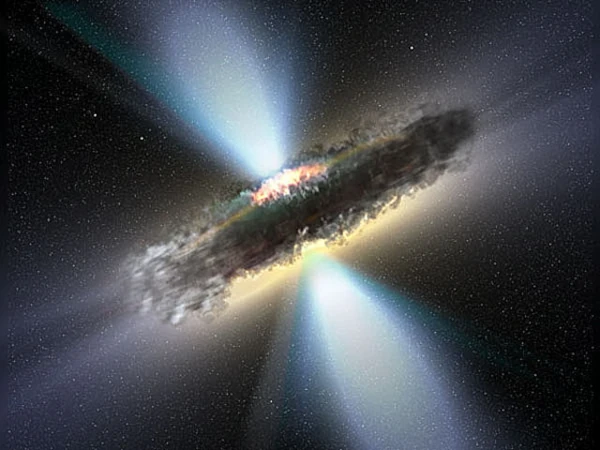
Black holes are astrophysical objects whose gravitational field is so intense that no light can escape, making them invisible. These objects are formed by the gravitational collapse of the core of massive stars (supernova). This reality, anticipated as early as the 18th century by John Michell (1724 - 1793), is now rigorously described by general relativity, which defines the event horizon as the insurmountable limit for any particle or radiation.
A black hole can be detected by its gravitational influence on its surroundings. In astrophysics, this translates into the study of the movement of stars or gas around a region where no light source is visible.
Black holes in the accretion phase attract surrounding matter, which forms a hot disk rotating at high speed. Internal friction raises the temperature of the disk to several million kelvins, causing the emission of X-rays detectable by specialized satellites (e.g., Chandra, XMM-Newton).
The spectrum and variability of X-ray radiation provide information about the mass, rotation speed (spin), and structure of the environment near the black hole.
The historic image of the shadow of the supermassive black hole in M87 by the Event Horizon Telescope (EHT) in 2019 was a major breakthrough. This global network of radio telescopes operates using very long baseline interferometry (VLBI), providing sufficient angular resolution to "see" the shadow of the black hole surrounded by the accretion disk.
The coalescence of binary black holes produces gravitational waves detected by ground-based interferometers (LIGO, Virgo, KAGRA). These waves are deformations of spacetime, measured using ultra-sensitive laser interferometers capable of detecting length variations on the order of 10-19 m.
The analysis of the waveforms allows extracting the masses, spins, and distances of the observed systems, providing a new observation channel to study the extreme physics of black holes.
| Method | Physical principle | Type of signal detected | Examples of instruments |
|---|---|---|---|
| Gravitational influence | Effect on the orbital motion of stars and gas | Velocity curves, gravitational lenses | Optical observatories: VLT, Keck |
| X-ray radiation from accretion disks | Heat due to friction and ionization in the disk | X-rays | Satellites: Chandra, XMM-Newton |
| VLBI radio imaging | High angular resolution interferometry | Direct image of the black hole's shadow | Event Horizon Telescope (EHT) |
| Gravitational waves | Temporal deformations of spacetime during fusion | Gravitational signals in audio frequency | LIGO, Virgo, KAGRA |
Sources:
• Misner, C.W., Thorne, K.S., Wheeler, J.A., Gravitation, 1973.
• Abbott B. et al., Observation of Gravitational Waves from a Binary Black Hole Merger, Phys. Rev. Lett. 116, 2016.
• Event Horizon Telescope Collaboration, First M87 Event Horizon Telescope Results, Astrophys. J. Lett. 875, 2019.
• NASA Chandra X-ray Observatory, https://chandra.harvard.edu
Black holes are not solely the result of stellar evolution: some may have existed since the first seconds following the Big Bang. These are known as primordial black holes. Unlike stellar black holes, these hypothetical objects would not have originated from the collapse of stars but from extreme density fluctuations in the primordial universe, amplified by rapid expansion during cosmic inflation.
According to physical models, certain regions of space could have locally exceeded a critical density, causing an immediate gravitational collapse. If these primordial black holes really existed (or still exist), they could have a wide range of masses, from less than an asteroid to several thousand solar masses. Their presence could notably help explain a fraction of dark matter, although no direct detection has yet confirmed their existence.
In this sense, black holes are not only objects born from stars but could be witnesses to the extreme conditions of the primordial universe. Their study would thus allow testing fundamental theories of physics, such as inflation, quantum gravity, or unification models.
| Characteristic | Primordial Black Holes | Stellar Black Holes |
|---|---|---|
| Origin | Density fluctuations in the primordial universe, post-Big Bang | Gravitational collapse of the core of massive stars after supernova |
| Formation Period | Within the first second after the Big Bang | Hundreds of millions of years after the Big Bang (after the formation of massive stars) |
| Mass Range | From $\sim10^{-5}$ g (Planck mass) to several thousand solar masses | From a few to tens of solar masses |
| Observation | Hypothetical to date, no direct detection | Confirmed by X-ray radiation, gravitational waves, stellar dynamics |
| Potential Cosmological Role | Possible candidates for dark matter; test of physics beyond the Standard Model | Common products of stellar evolution in galaxies |
References:
• Carr B.J., Hawking S.W., Black holes in the early Universe, MNRAS, 168, 399–416 (1974).
• Carr B.J., Kühnel F., Primordial Black Holes as Dark Matter Candidates, Annual Review of Nuclear and Particle Science, 70, 355–394 (2020).
• Sasaki M. et al., Primordial Black Holes—Perspectives in Gravitational Wave Astronomy, Classical and Quantum Gravity, 35(6), 063001 (2018).
• Zel’dovich Y.B., Novikov I.D., Relativistic Astrophysics Vol. 1, University of Chicago Press (1971).
• Abbott B. et al. (LIGO Scientific Collaboration and Virgo Collaboration), GWTC-3: Compact Binary Coalescences Observed by LIGO and Virgo During the Second Part of the Third Observing Run, Phys. Rev. X 11, 021053 (2021).